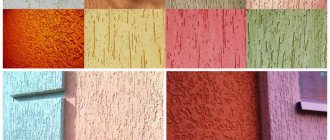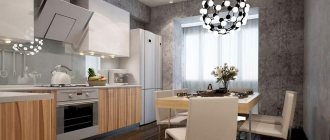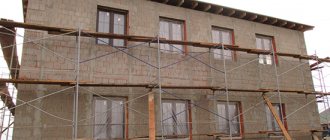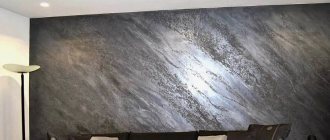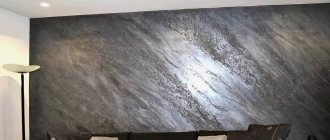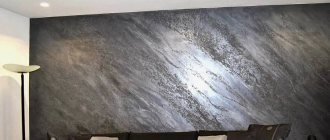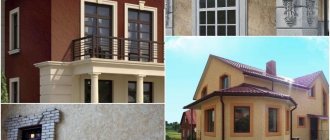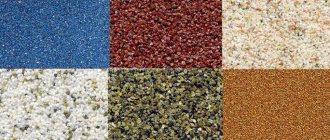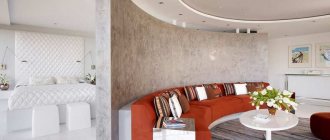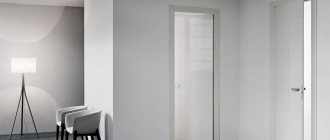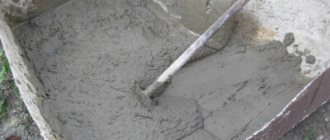Features of the material
By bark beetle plaster we mean a construction plaster mixture of a certain consistency, which includes the addition of mineral or polymer components to give a special structure to the finished coating. This material came to the Russian Federation and CIS countries from the West, where it has been popular for decades.
The main difference between bark beetle and conventional plasters is the presence of small pebbles (filler), which are evenly distributed throughout the mass. The filler can be:
- marble or other stone chips;
- artificial acrylic resin in the form of flakes;
- titanium dioxide;
- mineral particles.
The formation of a beautiful texture, reminiscent of wood eaten by bugs, also depends on the technique of applying plaster, the experience of the master, and the type and size of the working tool. Patterns are made using a trowel or a construction float. When certain movements are made, the granular fractional filler creates characteristic grooves. The latter give interesting outlines, unique designs, which look unusual and catchy.
Creating a decorative coating Bark beetle
Criterias of choice
The basic selection criterion is the type of base. Concrete surfaces are finished using cement-lime and cement mortars; there are no restrictions for brick surfaces. To improve the adhesion of both types of surfaces, a reinforcing mesh is applied to a 5 cm layer of the mixture.
Wooden walls are finished using lime-gypsum mortars, where clay can be added as a plasticizer.
It is important to comply with the permissible norm of the last component so that cracks do not form on the finished surface. Plastering a wood base also involves the use of reinforcing mesh.
Decoration of gypsum blocks is carried out using lime-gypsum or gypsum types of plaster; reinforcing mesh is not required. The use of cement mortars is highly undesirable here.
It is most difficult to work with gas and foam blocks, as they are characterized by low adhesion. To achieve reliable and long-term adhesion of materials, it is advisable to fill the surface with a special mesh and use mixtures with strengthening additives.
When choosing a finishing material, most experts prefer gypsum compositions, as they exhibit optimal performance characteristics. This type of bark beetle does not shrink and cracks do not form on it. The material has high sound and heat insulation properties. The only limitation: the gypsum mixture cannot be applied to concrete walls, it will quickly fall off, and it also requires high-quality preliminary waterproofing of the base.
Types of plasters
There are many plasters on sale that differ in composition, scope of application, and appearance. Even decorative bark beetle plaster is available in different versions, which are not the same in price and characteristics. The exact cost depends on the components included and the country of origin.
Acrylic
Acrylic plaster is made on the basis of synthetic acrylic resins. It is durable, ductile, has a medium degree of elasticity, is tinted in a variety of shades and can be painted. Acrylic material lasts for many years and does not deteriorate; it is not afraid of mechanical and physical impacts. If acrylic plaster partially chips, the damaged area can be restored without any problems.
Applying such a plaster mixture is not difficult - it is easily applied and distributed with any suitable tool. Many mixtures are frost-resistant, as they contain special additives that increase resistance to temperature changes. The use of walls with acrylic coating is possible in almost any conditions.
Ready-made acrylic plaster De Luxe
The disadvantages include the reduced vapor permeability of acrylic, as well as the inability to withstand strong movements of the walls when they shrink. In addition, acrylic is considered a flammable substance, therefore fire retardants must be present in the composition of such plaster. Despite this, it should not be applied near highly heated areas, as well as near an open fire.
Mineral
Such plasters contain cement, which acts as a binder, as well as gypsum, sand, other mineral components and modifying additives. They are always sold in dry (powder) form, since they have a limited residence time in liquid form before hardening. Cement-based plasters are inexpensive, suitable for exterior and interior use, and therefore are considered universal.
Dry mixture Bark beetle for decorative finishing
Mineral-based bark beetle plaster may include filler particles of different fractions. Depending on the exact size of the pebbles, a pattern is formed that can resemble small stripes, spots and grooves or give a large-relief surface. Before starting work, you need to dilute the mixture with water, mix thoroughly and begin application. The only disadvantages of mineral plasters are their rigidity and low elasticity. If the house has not yet passed the shrinkage stage, it is not recommended to apply them to the walls.
Silicate based
Plaster with the addition of liquid glass (a water-alkaline solution of potassium silicate) is the most expensive, but incredibly strong, durable and resistant to heat and freezing. It is usually used for facade work, although indoors it will also help create a beautiful and reliable coating. Silicate-based bark beetle has a high degree of vapor permeability and does not disturb the microclimate in the house. Its interesting property is its ability to self-clean, since dust and dirt do not stick to the surface.
This plaster is ideal for regions with extreme climates, where other coatings deteriorate quite quickly. It looks very attractive because it contains inclusions of colored or white mineral fillers, marble chips, and fragments of other rocks. Silicate plaster is sold ready-made in buckets and jars. White material can be tinted in any color.
Decorative plaster based on silicate SILIKATSTONE
Facade for exterior work
Treating facades with bark beetle plaster allows you to create an original pattern that imitates traces of beetles in solid wood. This type of coating makes the exterior of the house rich, luxurious, and unusual. In addition, the bark beetle for facade work also has practical functions. For example, it hides all defects and irregularities, so there is no need to perfectly level the walls before plastering.
Most often, mineral or silicate based plasters are used for exterior decoration of houses. Silicate coatings are quite expensive, although they are ideal for treating facades. The advantages of plastering buildings with bark beetle are obvious:
- no additional load on the walls due to low weight;
- tolerance to high and low temperatures (on average, in the range of –55…+60 degrees);
- easy cleaning, can be washed with a hose;
- no damage from rain, snow, wind, ultraviolet radiation.
Facade decorative mixture Aqualit
Material for interior decoration
No less often, bark beetle plaster is used to decorate the interior of houses and apartments. It allows you to quickly and inexpensively transform your home; it is suitable for the bedroom, kitchen, living room, nursery, office, hall and corridor. Plaster can be applied to walls made from most popular building materials. Only on plasterboard is it laid after preliminary preparation of the base and application of a thick layer of special putty.
Bark beetle for indoor use is valued due to its low cost, ease of application, environmental friendliness of the composition and excellent performance characteristics. It is usually not applied to the ceiling, since the porous coating will not adhere well in a “hanging” position. Using plaster on the floor also does not make sense, because it will be difficult to distribute it evenly, and the pattern will quickly wear out from walking.
Using bark beetle coating for interior decoration
Textured
Any bark beetle belongs to the so-called textured plasters - mixtures with a heterogeneous consistency, intended for decorative finishing of premises. In this case, the filler of the mixture and the method of its application are responsible for the texture. After rubbing the bark beetle, an individual texture will be created on the surface, hiding all the imperfections of the wall. It is thanks to its interesting texture that plaster is actively used to decorate rooms and facades, allowing the most whimsical design fantasies to come to life.
Roller room
Roller plaster is understood as a hardening pebble mixture based on quick-drying binders, which allows you to decorate surfaces. Usually, the filler here is fractionated stone chips, which create characteristic grooves on the surface. To obtain an additional fine pattern, quartz sand is added to the composition. A distinctive feature of roller plaster is the formation of an absolutely seamless wall covering.
Gypsum or acrylic resin can serve as a quick-drying base in roller plasters. The material is characterized by high adhesion to various building substrates and ease of application with a regular construction trowel. Bark beetle roller plaster varies depending on the size of the particles that are included in its composition:
- fine-grained - with granules 1-1.5 mm;
- medium fraction - with granules 1.5-2 mm;
- coarse-grained - with grains up to 2.5 mm.
Medium fraction decorative plaster
Ready solutions
The easiest way to work is with bark beetle, which is sold in finished form - packaged in jars and plastic buckets. Plaster of different brands is sold at any hardware store. Most often it is white, but can be tinted or painted after application and drying. It is important to properly store and transport such material, because it may lose some of its properties. It is prohibited to dilute the finished bark beetle with water, otherwise its strength will decrease.
Ready-to-use Osnovit plaster
Dry mixes
Mineral plasters based on cement and stone chips and sand are usually sold in dry form. They cannot be sold with the addition of water, because the cement hardens quickly. Powder mixtures can be stored for a long time if the necessary conditions are met (no dampness). They can be diluted exactly in the quantity needed for one pass, which will eliminate material loss. When diluting, it is important to strictly follow the proportions of water and dry matter specified by the manufacturer, otherwise the consistency of the mass will be unsuitable for work.
Useful tips
To ensure that finishing does not cause difficulties, you need to start by purchasing a good decorative mixture. To do this, you should take note of a few simple recommendations:
- If you plan to finish large areas, then it is better to buy powder material - it is economical, eliminates waste and is easy to store.
- It is worth carefully looking at the purpose of the mixture, which is indicated on the manufacturer’s labeling. If you ignore this aspect, the buyer risks buying the wrong material, which will affect the result.
- In order to correctly purchase the required composition, it is necessary to take into account the features of its application and the conditions of planned operation.
- The material is not taken end-to-end, since in the process of finishing surfaces, defects cannot be ruled out, and a lack of material can ruin the entire work.
- Mixing the plaster with a construction mixer reduces the time it takes to use the mixture: the better and more fluffy the mixture is whipped, the faster it dries.
- You should thoroughly wash the container before mixing a new portion - the hardened remains of the plaster mixture will cause heterogeneity in the fresh mass.
- The pattern is not applied twice. You should not count on constant adjustments - it spoils the integrity of the drawing being performed.
- To make a Venetian pattern, you can buy a special spatula with the desired relief - this approach will allow you to make a drawing at a professional level.
- Different thicknesses of the applied layer should not be allowed. The relief coating must be uniform, otherwise the visual effect will vary.
- Decorative plaster and liquid wallpaper are not the same thing. Do not confuse them, because it is the plaster mixture that will give the relief and allow you to draw on the surface.
You should know that each style has its own shades and patterns. The textured decor of each direction is individual. For example, for a loft style, a pattern in the form of brickwork is preferable. An office or bedroom in the spirit of vintage styles can be decorated with Versailles or Venetian plaster.
Design and colors
With the help of bark beetle you can create various textures and design options. When changing the application technique, even using the same plaster, different patterns appear, which designers really like. Examples of options for wall cladding with bark beetle are:
- Rain effect. If you move in different directions, you can get stripes in the form of flowing raindrops.
- Clouds. Moving the spatula in a circle helps create an imitation of clouds on the wall.
- Chaotic ornament. The tool is moved in any order, without a system, sharply, abruptly, and as a result a unique chaotic pattern is obtained.
Application of decorative plaster with a Cloud effect.
The bark beetle can also be decorated during application or after drying, which also gives a lot of scope for the designer’s imagination:
- Old walls. As the plaster hardens, copper, silver, and gold spots are applied to it with appropriate paint, leaving white gaps. This decor is well suited for vintage, antique, and classic styles.
- Abstract roughness. The first layer is made a couple of tones darker than the second, which is light and rubbed into the base. As a result, the rough surface becomes visually voluminous.
- Craquelure. With the help of special varnishes on plaster, bark beetles create the effect of cracks and an aged surface.
- Mother of pearl silk. Typically, such coatings are used to decorate bedrooms and living rooms. Thanks to the introduction of special pigments, the surface resembles silk fabric.
Bark beetle plaster with a craquelure effect in the kitchen interior.
The base color of the bark beetle is considered to be white. With the help of tinting, you can change it to any other, and there are an endless variety of tint options. You can introduce dry or liquid pigment into the plaster before application, or paint the finished coating after it has dried. To choose a specific shade, you need to take into account the style, design of the room, the color type of the decor, and the location of the room (north or south). It is important that the shades are in harmony with each other, and they can be similar or contrasting.
Preparatory stage
Before applying bark beetle plaster, you need to clean the base surface from greasy stains, dust and dirt, and old finishes. Cracks and defects are leveled using lime, gypsum, and cement mortar. In the process of sealing large seams, they are widened with a grinder and filled with gypsum putty. Walls in areas with high humidity levels are coated with antifungal compounds.
To improve adhesion, apply a thick acrylic primer to the surface using a brush, roller or spray gun. This composition will help adjust the absorbency of the base and speed up the uniform drying of the bark beetle. This measure is not necessary for cement-lime and concrete walls; here it is enough to wet the surface with water an hour before starting work.
Application area of plaster
Bark beetle, like other decorative plasters, is a finishing material, so it is applied as the last layer. It is well suited for bases made of concrete, brick, plasterboard, cement. The main thing is that the substrate is durable, does not crumble or sag. It is not recommended to use this plaster on wood and metal, and on plastic and glass the pattern may not form correctly.
Bark beetle plaster is excellent for interior decoration - finishing walls, highlighting certain parts of the room, individual zones. It can also be used to decorate arches, columns, niches - it all depends on the decorator’s imagination. You can use different shades of plaster or cover the walls with areas of different grains, which will give a variety of visual effects. The bark beetle looks no less good when decorating the facades of houses, buildings, structures and even multi-story structures.
How to determine if there is a bark beetle in the garden
The presence of a bark beetle can be determined by the following signs:
Holes in wood or boards. When a female bark beetle penetrates a plant (or board, timber), she gnaws a small entrance hole. Usually its diameter is no more than 0.5 cm. The hole can be easily seen with the naked eye upon careful examination.
Drill flour. The female carefully pushes the spent wood out of the uterine chamber. Sometimes she chews additional holes to do this. Such wood is called drill flour. If there is a bark beetle in your house or garden, sooner or later small piles of it will appear in the insect’s habitat.
Sound. When an adult beetle or larva gnaws on a tree, a characteristic sound is heard, vaguely reminiscent of the ticking of a mechanical watch. During the day, bark beetles most often do not show themselves. But in the evening or at night they begin their “subversive work.”
Dried branches and bark
If the bark beetle has been “in charge” of a tree for a long time, its presence may be indicated by dead bark or dried branches.
Attention woodpeckers. Woodpeckers in the garden are rare guests
However, sometimes they still fly there. If a bird has chosen a fruit plant, it means there are definitely larvae in it. A woodpecker will never “peck” a tree just like that.
Advantages and disadvantages
The bark beetle has a lot of advantages, which makes it very popular in interior and exterior finishing works:
- Resistance to external influences. Most brands of plaster are not afraid of temperature changes, ultraviolet radiation, dampness, direct contact with water, as well as mechanical action. Fungus and mold do not grow on the bark beetle.
- Safety. No harmful components are used to make the plaster mixture, so even when used internally it does not emit toxic fumes. If you use plaster to decorate walls, it will not emit unpleasant odors.
- Long service life. Thanks to its strength and wear resistance, the plaster will last at least 15 years, and some compositions do not deteriorate at all for decades.
- Easy to apply. The material lays flat and is easily smoothed with construction tools. The texture is also created without any problems. The surface does not need to be leveled too thoroughly before work.
- Elementary care. The bark beetle is low maintenance and can be washed, wiped, rinsed, vacuumed and brushed. Even if stubborn stains appear, you can correct the situation: just paint the damaged area. It is also possible to change the color, and without the involvement of specialists.
- Low price. Mineral plasters are available to everyone; their price usually does not exceed 250-350 rubles per package of 25 kg. Ready-made mixtures based on acrylic and silicates are much more expensive.
Plaster has few disadvantages. If the surface is chipped, the area will have to be restored, and this has a number of difficulties. You need to try to ensure that the pattern on the restored area exactly matches the original one, otherwise this piece of plaster will stand out against the background of the rest of the coating. Beginners may find it difficult to paint plaster, because the fibers of the tool do not penetrate well into grooves and grooves. Due to the characteristics of the relief, painting will take longer than on a smooth surface.
Founds
The main function of the Osnovit finish is to create not just a decorative, but also a protective layer. Most often used in systems with rigid insulation fastening. This finish is recommended for use in cultural and leisure centers, lobbies, hallways, administrative premises and common areas. The base can be cement and cement-lime plasters and putties, foam and aerated concrete.
Exterwell OS-1.0 WK, Osnovit, white (color-matched)
Price:
25 kg – 488 rub.
Characteristics:
- vapor permeability – 0.1 mg/mchPa;
- adhesion strength – 0.65 MPa;
- consumption – 1.6-1.8 kg/m2;
- grain size – 1.0 mm;
- frost resistance – 50 cycles;
- operating temperature – from -50 to +65;
- shelf life – 12 months.
Pros:
- variety of design;
- ease of application;
- Possibility of painting in any color.
Minuses:
No.
Exterwell OM-2.5 WK, Osnovit, super white
Cost:
25 kg – 889 rub.
Characteristics:
- vapor permeability coefficient – 0.1 mg/mchPa;
- adhesion – 0.65 MPa;
- consumption – 1.6-1.8 kg/m2;
- grain size – 2.5 mm;
- frost resistance – 50 cycles;
- operating temperature – from -50 to +65;
- shelf life – 12 months.
Advantages:
- variety of design;
- ease of application.
Flaw:
the large fraction is more suitable for outdoor work.
Application technology
To form a beautiful pattern, the layer of plaster must be at least 3 mm. There is also no need to sharply exceed this figure, otherwise the ornament will look blurry. You should work with the bark beetle at a temperature within +5...+30 degrees, humidity less than 85%.
Necessary tools, graters and consumables
To work with bark beetles, you need to prepare tools - a trowel, spatula, grater or grater. To mix the solution you will need a construction mixer and a container. Consumables when applying plaster are masking tape (for gluing the joints of the material) and rags (for wiping off splashes). Also, for the initial leveling of plaster over a large area, you need to have a rule.
A mandatory tool for shaping the texture of the bark beetle is a construction grater. In stores there are graters made from the following materials:
- wood - used on small surfaces, does not last long, as it quickly deteriorates from moisture;
- plastic - creates a thin, smooth layer, but does not tolerate active movements with strong pressure;
- polystyrene foam - breaks under excessive impact, but is quite suitable for one-time operations;
- polyurethane is the best option, ideal for beginners, highly valued by professionals for its durability and ease of use;
- metal - the material is used to make the most durable, but expensive graters.
Graters for decorative plaster
Preparing the base
The preparatory process should be treated as carefully as possible. The base is cleaned of the old coating, all peeling pieces of paint and plaster are removed. Large defects are repaired with a cement mixture, cracks that are too deep are expanded and reinforced with fiberglass. A layer of primer is applied, but not concrete contact is used, but a special primer with the addition of quartz sand.
Building facades with large differences are leveled along the beacons with cement plaster. If necessary, lay a layer of insulation (expanded polystyrene, penoplex, mineral wool), which is reinforced with mesh on top. Afterwards, the mesh is plastered with the usual composition, primed with a special agent in 2 layers, and only then they begin to treat the walls with bark beetle.
Reinforcement of the facade before applying plaster
Preparation of the composition
Before plastering walls or other substrates, you need to make a mixture. The finished plasters are simply mixed to prevent separation of the composition. If necessary, coloring is done by adding pigment and thoroughly kneading. Dry mixtures are diluted with water, introducing the powder in portions into a pre-measured liquid. The water for diluting the plaster should be cool (12-20 degrees). After mixing the mass with a mixer, let it stand for 10 minutes and get to work.
Preparation of plaster mortar
Application of bark beetle
The composition is scooped up with a spatula or trowel, after which it is applied to the wall, covering an area of about 1 square meter. Professionals lower the spatula into the container, take out a little solution and transfer it to the trowel. The plaster is applied to the wall from bottom to top, starting from the bottom corner and slowly rising to the top.
The remainder of the plaster after one stroke is put back into the container to then add the solution again. Next, the initial leveling is carried out using a rule or a large spatula, and the excess that remains on the tool is thrown away - there is little filler in it. Before forming the texture, allow the material to set a little (5-10 minutes).
Creating a drawing
The pattern is obtained by rolling plaster grains between the base and a construction float. When the solid granules move, they leave grooves and other elongated depressions. The final pattern will depend on the type of grain movement, so work can be done in different directions. Here are the basic techniques for creating a drawing:
- vertical movements with a grater - for the texture of rain;
- chaotic movements - to obtain a non-uniform image;
- spiral movements - to imitate lamb's wool.
To form grooves along the entire perimeter, the grater is pressed tightly to the surface and passed in the desired direction a certain number of times. After about half an hour, when the filler particles are firmly attached to the substrate, once again pass over them with a trowel using smoothing movements. If you need to take a break from work, cover the edge of the plaster layer with masking tape. After resuming plastering, they reach this area and remove the tape.
A poorly executed finish can be corrected with sandpaper. For this purpose, remove all rough areas and adhering lumps of plaster with coarse sandpaper, brush off the dust, and apply a thin layer of finishing white mixture (for example, “Rotband”). After it dries, prime the base with concrete contact, then apply another layer of primer with quartz sand. The last layer is applied with bark beetle in the standard manner. If it is assumed that the “double” coating will be too thick, then immediately remove all the plaster and do the work again.
Finishing
In order for the plaster layer to serve for a long time, it is protected with a finishing coating. Typically, plaster is treated with acrylic paint, latex composition or a special varnish for interior work. As for facades and other street surfaces, they are painted with products based on silicone, acrylic, silicates, which are not afraid of frost and precipitation.
The ideal option is to use paints and varnishes from the same manufacturer that produced the plaster for finishing. The adhesion of the compounds will be high, and the appearance of the finish will be smooth. Since the texture of bark beetle plaster is close to stone finishing, you can paint it the color of natural stone, which looks very stylish. For painting, large rollers with medium pile and a durable handle are used. If desired, after the varnish or paint has dried, wax is rubbed into the coating, which will give the surface a finished look.
Painting decorative plaster with a roller
Surface painting
Usually the paint is applied in 1-2 layers manually. On large areas, they try to work with a spray gun, because manual painting will be time-consuming and labor-intensive. Facade coatings are often painted one color, interior ones - one or two. You can only use acrylic varnish: tint the material, carefully rub it into the grooves and pits, and then apply wax on top.
Minuses
- If a chip forms as a result of mechanical damage or improper application, it is difficult to cover it with a uniform color composition (even for a highly qualified specialist);
- Seasonal work restrictions. Application of plaster is possible under certain temperature and humidity conditions;
- Before finishing, you need to thoroughly clean the surfaces from previous layers (with the exception of the process of applying wet plaster). If you treat this matter carelessly, then after drying, heterogeneous areas will begin to appear;
- If the technology in the preparation of the composition and application rules are violated, there is a risk of problems arising. Including:
— swelling (uniform or in individual areas) followed by peeling and destruction of the finishing layer;
— formation of horizontal and vertical cracks;
— heterogeneity of color (spotting);
When using particularly cheap materials, the appearance may deteriorate (chips, color fading, cracks) after 2-3 years. This is due to the use of low-quality ingredients in their composition;
Getting different effects
Thanks to the presence of pebble filler, decorative plaster can be used to create a variety of patterns, and not just the classic bark beetle that everyone is familiar with. It is important to choose the right time for applying the design: the plaster should dry out a little so as not to stick to your hand, but still remain unhardened.
Jets of rain
This pattern is created by vertically running a grater from top to bottom, while the length of the strips being made is regulated by the master.
slanting rain
In this case, the plaster is floated in the same way, only at a certain angle, and not vertically. Strictly monitor the preservation of the degree of angle, otherwise the drawing will be chaotic.
Bark beetle
The classic and simplest effect involves moving the grater in any direction. This method is best for beginners.
Horizontal bark beetle
To perform this ornament, the grater must slide horizontally, without deviation in each of the sections.
Two-colored bark beetle
Applying plaster in two colors is a more complex process than described above. You can achieve an interesting effect in two ways:
- The color is introduced into the plaster before the main stage of work is completed. After the layer has dried, paint the protruding elements with paint of a contrasting color using a short-nap roller.
- As the plaster dries, paint the wall with a fur roller in one color, thoroughly covering all the pits and grooves. Then the surface is treated with a second color using a foam roller.
Painting the bark beetle in two colors
As a result of using one or another technique, the depressions will take on one shade, and the bulges will take on another, which looks unusual and very beautiful.
Wall coloring
The final drying times for the mixtures are indicated on the packaging. Usually this process takes two days indoors; outdoors everything happens faster. The completely dry surface should be treated with fine sandpaper. If the walls were finished with colored acrylic compounds, then the work can be considered completed.
Cement, silicone or silicate plaster bark beetles are painted with various compositions. It is better to carry out the work using a construction roller with long pile to paint the grooves. Perform movements in horizontal and vertical directions. If, after drying, you treat the wall with a dye with a less saturated color using a velor roller, you can get tinted grooves. It looks impressive and gives the interior originality.
Using a new method of decorating walls instead of boring wallpaper will require a lot of time and effort. You will have to purchase tools and master the profession of plasterer. The original stylish interior, durability and practical properties of the new coating will justify all the efforts and additional costs.
Plaster consumption per square meter
Material consumption will depend on various indicators. Here are the main factors that influence the final figure:
- number and severity of base defects;
- substrate material (mineral bases “take up” more plaster);
- plaster composition and fraction size;
- the experience of the craftsman and the technique of work.
Mixture consumption depending on the size of mineral fractions
The approximate consumption is usually reflected on the packaging of the plaster mixture. It is always calculated based on the thickness of the layer, which will not be less than the size of the filler fraction. Typically, the average material consumption varies from 2 to 3.5 kg per square meter of surface.
Surface preparation
Before you start plastering the walls with bark beetle, you need to thoroughly prepare the surface. The main requirement is the absence of any potholes or protrusions. You should not hope that bark beetle façade plaster will hide defects in the base. On the contrary, if there is a protrusion on the wall, then it will be conspicuous - the granules will penetrate the plaster right through, and the wall will be visible through the layer. If the wall has potholes, then the granules will simply drown in a thick layer of plaster, and there will not be a beautiful pattern.
Therefore, it is necessary to remove any foreign objects - nails, plugs, etc. Holes should be repaired using cement mortar. If there was a poorly adhering coating on the wall - wallpaper, paint, old plaster - it must be removed.
You can check whether the surface is sufficiently level using a rule or a strip at least 200 cm long. Place it against the wall and check if there are gaps. No more than two openings with a maximum depth of 2 mm are allowed. If there are more irregularities or they are more noticeable, you need to first level the wall using regular plaster.
When the plaster or cement (if used) has dried, the wall needs to be finally prepared - remove dust, dirt, and oily stains. The easiest way to do this is with a damp cloth. The dried wall needs to be primed. This will not only allow you to get a white wall that will not change the color of the plaster, but also increase the adhesion of the surface, providing good adhesion.
The best manufacturers
Of the variety of foreign and domestic brands of plasters with bark beetle effect, it is worth highlighting the highest quality ones:
- Ceresit CT 175 - silicate-silicone plaster for facades and interior use with high vapor permeability;
- Ceresit CT 35 is an inexpensive cement mixture with mineral chips that has high wear resistance;
- Unis “Bark Beetle” - includes cement and marble filler, is not afraid of the sun, moisture;
- Bergauf Dekor - mineral plaster with modifiers, easily withstands the most severe frost;
- Ceresit CT 64 - acrylic plaster for interior work with a beautiful appearance;
- “Osnovit Bark Beetle 2 mm” is a cement mixture with mineral grains, it is quite cheap and easy to apply.
Decorative plaster Bergauf Dekor Fasad
There is a huge selection of decorative plasters, but mixtures that provide a coating of bark beetles are rightfully considered the most popular. They are easy to apply, simple and versatile, which is why they have earned the recognition of plasterers and designers.
